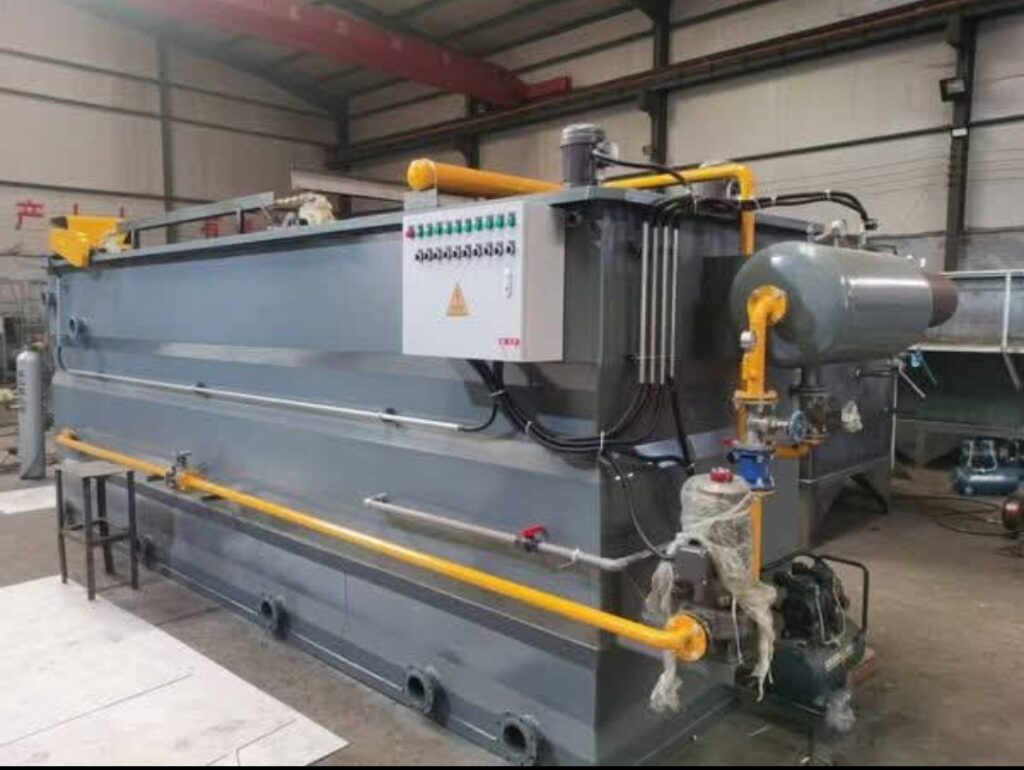
1. Pre-Treatment (Screening & Equalization)
- Objective: Remove large particles and balance the flow and composition of wastewater.
- Process:
- Wastewater first passes through coarse screens to remove large solids.
- It is then sent to an equalization tank where flow and pollutant loads are stabilized.
- pH may be adjusted to optimize chemical dosing.
2. Coagulation
- Objective: Destabilize suspended particles.
- Process:
- Coagulants such as alum, ferric chloride, or polyaluminum chloride (PAC) are added to the wastewater.
- These chemicals neutralize the charges of suspended particles, allowing them to aggregate.
3. Flocculation
- Objective: Form larger and heavier flocs from smaller particles.
- Process:
- Flocculants (usually polymers) are added to the water.
- Gentle mixing helps form flocs, which are clusters of suspended particles.
4. Saturation and Air Dissolution
- Objective: Dissolve air into water under pressure.
- Process:
- A side stream of clean or recycled water is taken and saturated with air in a pressure vessel (air saturation tank).
- Typically pressurized to 4–6 bar (60–90 psi).
5. Pressure Reduction (Air Release)
- Objective: Release dissolved air to create microbubbles.
- Process:
- The pressurized, air-saturated water is injected into the DAF flotation tank.
- As pressure drops to atmospheric, microbubbles (20–80 microns) are released.
6. Flotation and Separation
- Objective: Float flocculated solids to the surface.
- Process:
- The microbubbles attach to the flocs, making them buoyant.
- These floc-bubble aggregates rise to the surface and form a sludge layer.
- Cleaner water settles at the bottom.
7. Sludge Skimming
- Objective: Remove floated sludge from the surface.
- Process:
- A mechanical skimmer moves slowly across the surface of the DAF tank.
- It pushes the floated sludge into a sludge hopper or collection trough.
8. Treated Water Collection
- Objective: Collect clarified effluent.
- Process:
- The clarified water at the bottom flows through collection weirs or effluent launders.
- It can be discharged or sent to further treatment like sand filtration, UV disinfection, or biological treatment.
9. Sludge Handling
- Objective: Dewater and dispose of sludge.
- Process:
- The skimmed sludge is pumped to a sludge thickener or dewatering unit (e.g., filter press, centrifuge).
- Dewatered sludge is sent for disposal or further processing.
10. Recycle Stream
- Objective: Enhance efficiency of bubble generation.
- Process:
- A part of the clarified effluent is recycled back to the air saturation tank to continue the DAF cycle.
🔁 DAF Process Flow Summary (Step-by-Step)
- Inlet Wastewater →
- Screening & Equalization Tank →
- Chemical Dosing (Coagulant + Flocculant) →
- Flocculation Tank →
- Air Saturation System (Pressurized) →
- DAF Tank (Microbubble Injection) →
- Floc-Bubble Floatation →
- Sludge Skimming →
- Effluent Discharge or Reuse →
- Sludge Dewatering
✅ Advantages of DAF Systems
- High efficiency in removing fats, oils, greases (FOG).
- Compact footprint.
- Produces high-quality effluent.
- Works well for high solids or high oil content wastewaters.
🏢 DAF Systems by Healthy Enviro Solutions Pvt Ltd
At Healthy Enviro Solutions Pvt Ltd, we specialize in providing customized DAF water treatment systems for a variety of industrial and municipal applications.
📞 Contact us today at 9040005060 for expert consultation and reliable DAF solutions.
Would you like a diagram of the DAF process or a printable brochure with this content?